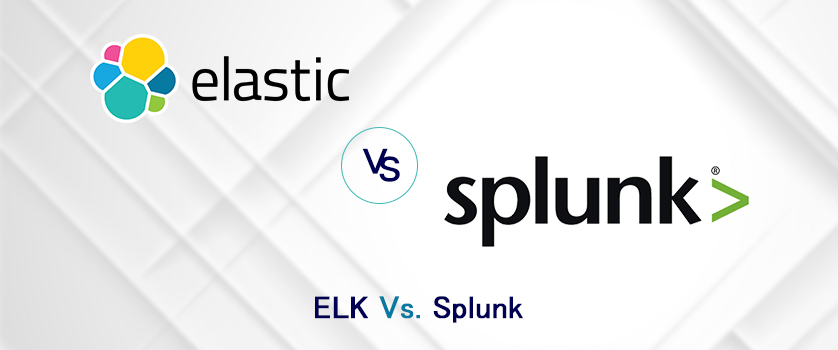


Automation is a key component of DevOps that encapsulates the entire development process from build and development to testing, deployment, and monitoring. It enables teams to collaborate better and focus on more critical tasks, which facilitates speed, consistency, higher accuracy, reliability, and an increased number of deliveries. Considering these benefits, it’s no surprise that organizations today rely primarily on various DevOps automation tools for miscellaneous tasks.
ELK Stack (Elasticsearch, Logstash, Kibana) and Splunk are two such prominent DevOps automation tools used by organizations for operational data analytics and log management. These two play a crucial role in ensuring organizations’ security, as they offer insights into the actions and events occurring inside their infrastructures. Both ELK and Splunk monitor and analyze infrastructure in IT operations to ensure maximum application monitoring, security, and business intelligence and deliver actionable intelligence from the sea of data.
Though ELK and Splunk are two similar tools designed to serve a similar purpose, their differences cannot be overlooked.
Therefore, in this article, we have highlighted the major differences between these two log management tools.
An acronym for three open source projects, Elasticsearch, Logstash, and Kibana, ELK or ELK stack, is an open-source log management and analytics solution for monitoring infrastructure and processing server logs, application logs, data, and clickstreams.
Developed, managed, and maintained by Elastic, ELK Stack is a simple, robust log analysis tool that helps developers and DevOps engineers gain valuable insights on failure diagnosis, application performance, and infrastructure monitoring. It enables DevOps teams to effectively aggregate logs from all systems and applications, analyze logs, and create visualizations and infrastructure monitoring, ensure faster troubleshooting and security analytics, etc.
ELK Stack is a powerful platform popular among DevOps engineers due to its ability to collect and process data from multiple data sources. Moreover, it helps organizations store data in one centralized and scalable data store and provides necessary tools for data analysis. Other prominent features and advantages of ELK Stack include:
A widely used software platform, Splunk helps monitor, search, analyze, and visualize machine-generated data in real-time. Used for data visualization, report generation, data analysis, etc. Splunk effectively handles a large volume of data and provides lightning-fast results.
Splunk efficiently captures, indexes, and correlates data, in real-time, from a searchable repository and generates insightful graphs, reports, dashboards, visualizations, and alerts. Moreover, it helps provide easy-to-access data over the whole organization for easy diagnostics and solutions to various business problems. With Splunk, organizations can build cloud applications that are highly scalable and reliable, as it does not require complicated databases, connectors, or controls that impact its performance and security.
Splunk is one the most efficient tools that easily monitors different infrastructure performances, troubleshoots issues, creates dashboards, reports, and alerts. Available in three different versions, Splunk Enterprise, Splunk Light, and Splunk Cloud, Splunk effectively gathers and analyzes data from applications to summarize and collect valuable information that helps businesses generate improved ROI faster. Some of its other features and benefits are:
For a comprehensive understanding of Splunk, check out the complete guide here.
As stated earlier, though ELK and Splunk share a similar objective, they are significantly different in their performance, functioning, and processes. Hence, the following table highlights the major differences between ELK and Splunk.
| ELK | Splunk |
|---|---|
| It is an open-source, free tool. | It is a paid, commercial tool. |
| It is a complete technology stack with Elasticsearch, Logstash, and Kibana. | A proprietary tool with both on-premise and cloud solutions. |
| It cannot integrate easily with other tools. | Can easily be integrated with other tools. |
| Uses custom MapReduce as a search engine. | Uses Apache Lucene as a search engine. |
| Its user management feature is more challenging. | Offers a dashboard with more features than ELK. |
| Offers limited processing speed. | Ensures the accuracy and speed of processes. |
| Uses LogStash Shipper or FileBeat for data collection. | Uses Splunk Universal Forwarder for data collection. |
| ELK’s Elasticsearch leverages the standard RESTful API and JSON. | Has a well-documented RESTful API, with over 200 endpoints. |
| Uses Query DSL language for search. | Uses Splunk Processing Language for search. |
| Uses Java-based Apache Lucene for indexing. | Uses C++-based proprietary for indexing. |
ELK and Splunk are two excellent log management solutions with unique advantages and features. While ELK is a popular open-source, consolidated data analytics platform, Splunk, on the other hand, is one of the best DevOps tools in the market, with some remarkable features. Though both ELK and Splunk help organizations leverage their data to get the best business outcomes, opting one above the other can only depend on the organizations’ specific requirements, infrastructure size, and cost.